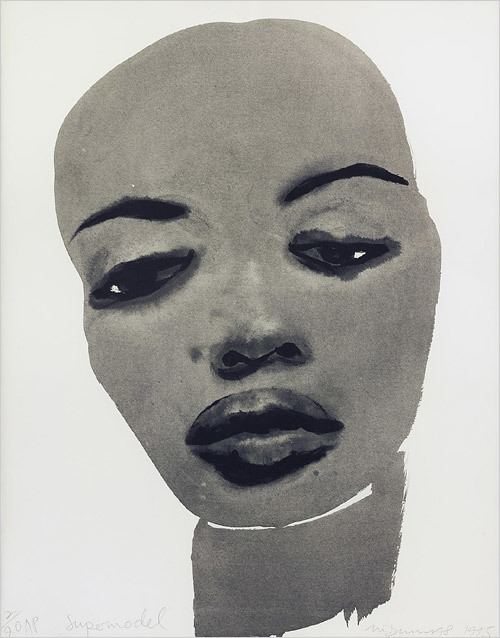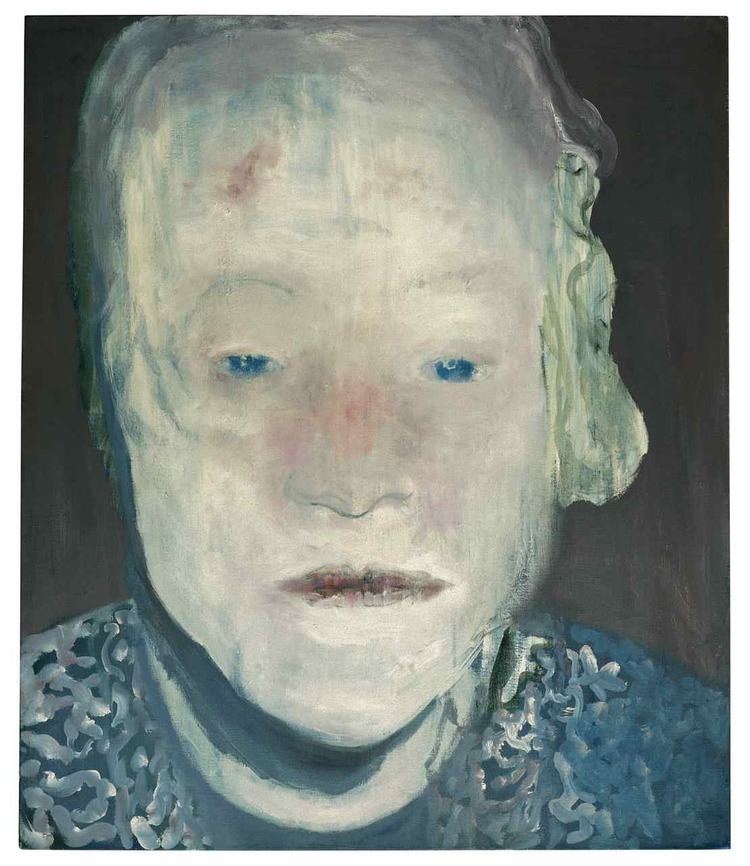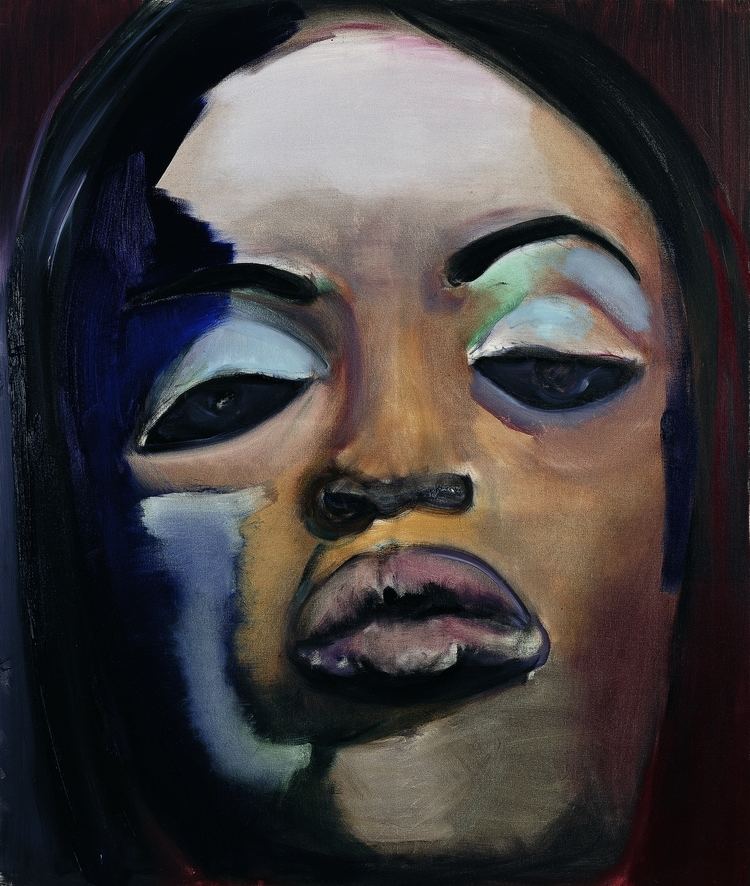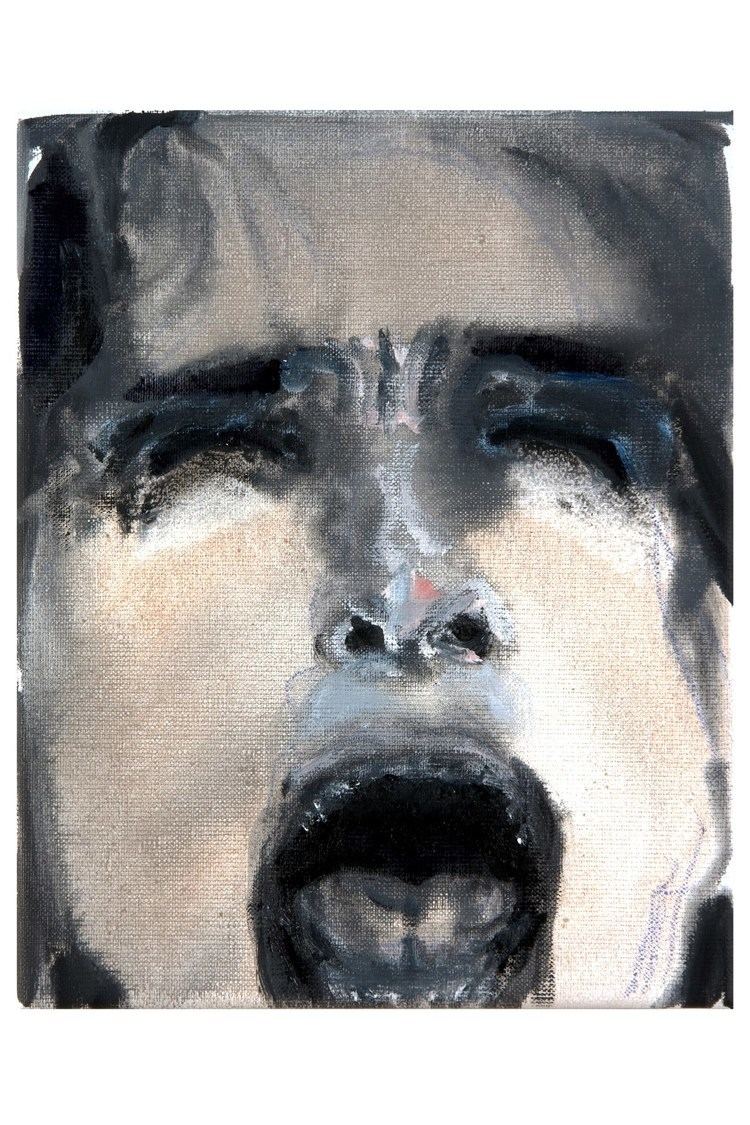Role Artist | Name Marlene Dumas Website www.marlenedumas.nl Children Helena Dumas | |
 | ||
Movies Kentridge and Dumas in Conversation, Alice Neel, The Future is Now! Books Marlene Dumas: Wet Drea, Marlene Dumas: Intimate, Marlene Dumas: Measurin, Marlene Dumas: Selected, Against the Wall Similar People Jenny Saville, Jean‑Christophe Ammann, Thomas Demand, Peter Doig, Otto Dix | ||
Marlene dumas the image as burden
Marlene Dumas (born 3 August 1953) is a South African born artist and painter who lives and works in Amsterdam, the Netherlands. In the past Dumas produced paintings, collages, drawings, prints and installations. She now works mainly with oil on canvas and ink and watercolor on paper. Almost all of Marlene Dumas's paintings can be traced back to a photographic source, either collected from the media or taken by the artist herself.
Contents
- Marlene dumas the image as burden
- Marlene dumas in her studio
- Early Years
- Work
- Writing
- Teaching
- Exhibitions
- Collections
- Recognition
- Art market
- References

Marlene dumas in her studio
Early Years

Marlene Dumas was born on a wine farm in Kuilsrivier, a semi-rural area in the outskirts of Cape Town in South Africa. She attended Bloemhof Girls' High in Stellenbosch after her father's death in 1966. Among her schoolmates were Marlene van Niekerk and Sandra Kriel, who also is an artist. Dumas attended the University of Cape Town's Michaelis School of Fine Art. The artist describes the impact art school had on her and her art: " Art school in South Africa was very stimulating in a theoretical way, issues that only now are becoming important for some Europeans, like... what is political art? I learn a lot about ethics, philosophy and theory in South Africa, while in Holland I started to look at paintings for the first time. I started to appreciate the pictorial or visual intelligence of remarkable paintings. So, that's important to my work, as well as being white in a black country influenced my philosophy in life. I was not the victim of the bad system. I was part of the wrong system. So I don't make work about being victimized (although apartheid as a whole was very bad for the spirit of its people). I rather find everyone capable of terrible things and I fear my own weakness and blindness first". In the summer of 1976, Marlene Dumas moved to Europe.
Work

Dumas attended the University of Cape Town in Cape Town, South Africa from 1972-1975 and relocated to Amsterdam in 1976, where she attended the University of Amsterdam as a student of painting and psychology from 1979-1980. At this time, Dumas was aspiring to be an abstract painter and was influenced by artists such as Willem de Kooning and Gerhard Richter. The works Dumas produced between 1975 and 1979 demonstrate the development in the artist's characteristic style, where the subject matter; the apartheid in South Africa, is presented in abstract style in painting. As Cornelia Butler, the curator of Dumas's retrospective exhibition "Measuring Your Own Grave" in Tate Modern asserts, "Dumas's paintings are products of the contemporary image world - that is, they are drawn from directly from the events of our time, abstracted to resonate in content and form." In 1984, Dumas started painting heads and figures. These head and figure drawings were usually ink-wash based. Between the years 1979 to 1984, Marlene Dumas took a break from painting, and she primarily produced works on paper. These works are often a collage of drawings in pencil, ink or crayon with a title or a quote, newspaper clippings and magazines and sometimes objects. The paper used would usually be cut from a large roll, scratched, stained and torn. A series of paintings she executed in the mid-1980s, titled "The Eyes of the Night Creatures", explores recurring themes in the artist's oeuvre, including racial and ethical intolerance. Dumas also gained recognition on the European scene for her series of painting in "The Eyes of the Night Creatures." The White Disease (1985) is a painting of an ageing South African woman with pale blue eyes taken from a medical photograph. The painting projects the disease of apartheid and Dumas acknowledges it as one of her favourites. Christie's auction lot notes observes that the painting recalls the influence of predecessors such as Egon Schiele and Leon Golub. Translucent white paint creates a ghostly shade, alluding to the subject's illness, while water-saturated colors gives the portrait an unreal transparency, suggesting the fugitive nature of life. The shape of the nose is replaced by a simple blob of pink color, symbolising a loss of humanity and the subject's indifference to her state.

In the late 1980s and early 1990s, Dumas produced a series of works based around the subject of pregnancy and babies. Dumas states: "To create an artwork (to make an image of) and to give birth have essentially nothing to do with one another. Yet this is no reason to stop loving metaphors or avoiding the unrelated. But the poetry that results from mixing different kinds of language, disappears into sloppy thinking, when we imagine that these differences can ever be solved harmoniously; or even worse, when we forget that these realities we are mixing are of a beautiful and often cruel indifference towards each other." In 1987, she gave birth to her daughter, Helena, and a great body of work followed. The most compelling is The First People, which is a series of four canvases devoted to newborn infants. Each painting is large (many times greater than life-size) and each is composed vertically. She does not idealize her images; instead the babies are unattractive, squirming little beings with gnarled fingers and toes, bloated bellies, and wrinkled skin. Depicting a similar, rather horrifying, large baby is Warhol's Child, painted on a horizontal plane, during the same period. It is a homage to Alice Neel, specifically the portrait Andy Warhol (c.1970). Alice Neel is among the many artists who influenced Marlene Dumas's works.
In the 1990s, Dumas indirectly returned to the subject of apartheid. Between 1998 through 2000, in collaboration with the photographer Anton Corbijn, she worked on a project called "Stripping Girls", which took the strip clubs and peep shows of Amsterdam as their subject; while Corbijn exhibited photographs in the show, Dumas took Polaroids which she then used as sources for her pictures.

Since she first began painting portraits in the 1980s, famous figures ranging from Osama Bin Laden to Naomi Campbell, various family members, friends and even unknown persons have been the subjects of her work. The haunting and distorted faces and bodies of her figures are a product of her use of thinned down paint, wiping the pigment away from the canvas to create the washed out, smudged figures that are characteristic of her work. At times dark and disturbing, always weighted in poignancy, and drawn on topical and contentious material, she repeatedly mixes the personal with the political. She has said that her works are better appreciated as originals, to mirror the at times shocking, discomforting intimacy she captures with her works.
Dumas uses oil and water color in her paintings. Many of her works confront themes such as pornography and segregation. A large number of her symbolic paintings depict either erotic or disconcerting nude bodies in acts.
For Manifesta 10 in St Petersburg, Dumas created Great Men, a series of 16 ink and pencil portraits that depict famous gay men who have all influenced the artist, including James Baldwin, Leonard Matlovich, Rudolf Nureyev, Vaslav Nijinsky, Pyotr Ilyich Tchaikovsky, Alan Turing, Oscar Wilde and Tennessee Williams. Each of the men depicted was persecuted, in one way or another, because they were suspected of being gay. According to Dumas, the series is to "contribute to a mentality change" in Russia at a time of increasingly anti-gay legislation in the country.
Writing
In addition to being a visual artist, Dumas is also an active writer. Her exhibitions and their accompanying catalogues are populated by a number of Dumas' essays, poems, and passages about her work. A collection of these writings entitled Sweet Nothings: Notes and Texts was published by Tate in 2015. When used in conjunction with her work, Dumas' writing can be both helpful and confusing, contributing additional layers to the work's content and interpretation. Dumas is certainly not the first to use text in her work, but the way she directly addresses the reader by using the pronoun 'you' is a significant departure from Barbara Kruger's plural statements ('We won't play nature to your culture') and Jenny Holzer's objective truisms ('Abuse of power comes as no surprise').
Teaching
Dumas is committed to teaching. In a 2007 interview she said, "I see teaching as a very important thing, and not only because I teach [the students] things, but also because we have a dialogue, and you see what you really want. You find things out. I still believe in the Socratic dialogue. Art is really something that you learn from being around people". Marlene Dumas has also stated that she believes an artist defines and understand themselves only in relation to other artists, which is one of the reasons why she holds and attends lectures and discussions worldwide.
Exhibitions
Marlene Dumas's works have been exhibited in galleries across the US, Canada, Japan and Europe, including Netherlands, Germany, Switzerland, UK, Ireland, Sweden, France, Austria, Portugal, Iceland, Norway and Poland. While her first exhibition was in 1984, in the Centraal Museum in Netherlands, she was exhibited in her homeland only in 2008, pointing to her art's reception in South Africa. Dumas's first all-painting show was held in 1985, at the Galerie Paul Andriesse in Amsterdam, and it brought together nine portraits. Three of the portraits were of women named Martha; Martha Freud, the artist's grandmother, and a worker. The women depicted sharing the same name demonstrates the significance language holds for Marlene Dumas, who has repeatedly commented on her meticulous selection of the titles for her works.
In 1992 Dumas participated in Documenta IX in Kassel, Germany. Her catalogue entry for the show, My Thoughts on Big Shows presents the artist's perspective of group shows which she would attend many of throughout her career.
"It’s not possible to participate in - Big Shows - without feeling this urge - to bite - the hand that feeds you.
Give me a face instead of a place - I don’t understand Kassel (as a place) - it’s too grey, too cold and too - far away for me.
Give me - the head of - John the Baptist. "
In 1995 Dumas represented the Netherlands in the 46th Venice Biennale (together with Marijke van Warmerdam and Maria Roosen). Dumas's first international solo museum exhibition, "Marlene Dumas: Name No Names," opened at the New Museum in 2002. A major American museum exhibition and midcareer retrospective entitled "Measuring Your Own Grave", opened in June 2008 at the Museum of Contemporary Art, Los Angeles, and moved to the Museum of Modern Art in New York City and the Menil Collection in Houston. Also in 2008, the South African National Gallery, Cape Town, and the Standard Bank Gallery, Johannesburg, presented two consecutive shows of the artist’s work, marking the first time Dumas had solo exhibitions in her homeland. The Haus der Kunst, Munich, showed "Marlene Dumas: Tronies" in 2011. The Stedelijk Museum, the Tate Modern, and the Beyeler Foundation have organized a major retrospective of the artist called "Marlene Dumas: The Image as Burden", which includes artworks from the 1970s until 2014, set to debut in Amsterdam in September 2014 and due at the Tate 5 February - 10 May 2015.
In 2017, works of art by Marlene Dumas are on display as part of group exhibitions in the Het Atzewige Museum in Belgium; from April 20 until August 13, National Portrait Gallery in London; from March 27 until October 1, Galerie Gebr in Germany; from March 25 until April 29, and Rijksmuseum in the Netherlands; from February 17 until May 21.
Marlene Dumas's works will also be exhibited at the ABN AMRO Headquarters in Amsterdam; from January 19, 2017 until March 2018.
Dumas is represented by the David Zwirner Gallery, Gallery Koyanagi, Frith Street Gallery, Zeno X Gallery and Galerie Paul Andriesse.
Collections
Work by the artist is held in the public collections of various museums, including Rijksmuseum, Amsterdam, the ARKEN Museum for Moderne Kunst, Copenhagen; Art Institute of Chicago, Chicago; Bawag Foundation, Vienna; Bonnefantenmuseum, Maastricht; Carnegie Museum of Art, Pittsburgh; Centraal Museum, Utrecht; De Pont Museum of Contemporary Art, Tilburg; Centre Pompidou, Paris; Centro de Artes Visuales Helga de Alvear, Caceres; Dallas Museum of Art, Dallas; De Ateliers, Amsterdam, The Netherlands; The Flemish Ministry of Culture, Brussels; Fonds Regional d’Art Contemporain Picardie, Amiens; Gemeentemuseum, Arnhem, The Netherlands; Gemeentemuseum Den Haag, The Hague; Institute of Contemporary Art, Boston; South African National Gallery, Cape Town; Johannesburg Art Gallery, Johannesburg; Joods Historisch Museum, Amsterdam; Kasteel Wijlre / Hedge House, Wijlre, The Netherlands; Krannert Art Museum and Kinhead Pavilion, Champaign, Illinois; Kunsthalle zu Kiel der Christian-Albrechts-Universität, Kiel, Denmark; Lieve Van Gorp Foundation for Women Artists, Antwerp, Belgium; Los Angeles County Museum of Art, Los Angeles; Museum De Pont, Tilburg, The Netherlands; Museum für Moderne Kunst, Frankfurt; Museum het Domein, Sittard, The Netherlands; Museum of Contemporary Art, Los Angeles; Museum of Contemporary Art, Tokyo; The Museum of Modern Art, New York; Museum van Hedendaagse Kunst Antwerpen, Antwerp, Belgium; Museum voor Moderne Kunst, Arnhem, The Netherlands; Strasbourg Museum of Modern and Contemporary Art; Nasher Museum of Art, Durham; Paleis Vught, Vught, The Netherlands; Saatchi Gallery, London; Scheringa Museum voor Realisme, Spanbroek, The Netherlands; Stadsgalerij Heerlen, Heerlen, The Netherlands; Van Abbemuseum, Eindhoven; Stedelijk Museum, Amsterdam; Stedelijk Museum, Gouda, The Netherlands; Museum De Lakenhal, Leiden, The Netherlands; Stedelijk Museum Schiedam, Schiedam, The Netherlands; Stedelijk Museum voor Actuele Kunst, Ghent, Belgium; Tropenmuseum, Amsterdam; Tate Modern, London, England; and ZKM Zentrum für Kunst und Medientechnologie, Karlsruhe.
Recognition
Dumas has been awarded honorary doctorate degrees from the University of Antwerp (2015), Stellenbosch University (2011) and Rhodes University (2010). She was the winner of the 2011 edition of the Rolf Schock award in Stockholm.
In 1998, Dumas received the Coutts Contemporary Art Foundation Award. In 2007, Dumas received the Dusseldorf Art Prize. In 2012, Dumas won the Johannes Vermeer Award.
Art market
Dumas's artworks were first auctioned in 1994 in the Netherlands, where three paintings and drawings were sold for between $790 and $3,100. In 1999, following her debut exhibition at the Museum Kunst Hedendaagse in Antwerp, her drawing Checkered Skirt was sold for $22.000 at Christie's New York. By 2002, the record for Dumas's paintings, only a few of which had come to auction, stood at about $50,000. Jule, die Vrou (Jule, the Woman), a 1985 close-up of a transvestite's face, was auctioned at Christie's for $1.24 million in 2004. In 2005 at Christie's in London, The Teacher (Sub a) (1987), a rendering of a posed class photograph, was sold for $3.34 million. In 2008, The Visitor (1995) sold for £3.1 million at Sotheby's in 2008, making Dumas the most expensive living female artist at the time. In an interview conducted by a correspondent of Vogue, Dumas asserted that she is not at ease with being an artist whose works are being sold at such high prizes. She stated: “If you know the history of art, the people whose work fetched the highest prices have often been terrible artists”. However, most of Dumas’s works are sold to well-established institutions. Her portrait of the late Amy Winehouse, Amy-Blue (2011), was acquired by London’s National Portrait Gallery for £95,000 ($150,000) in November 2012.
